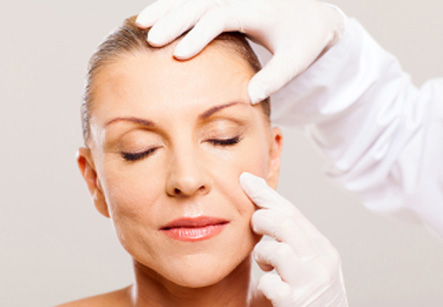Oculoplastics
Introduction
Oculoplastics, or oculoplastic surgery, is a branch of surgery which involves a wide variety of procedures dealing with the orbit (eye socket), eyelids, tear ducts, and the face. It also deals with the reconstruction of the eye and associated structures.
Training
Oculoplastic surgeons (ophthalmic plastic surgeons) are primarily ophthalmologists (eye surgeons). The eye surgeon receives specialized training required to diagnose and manage a wide range of disorders affecting the eyes and has acquired the skills needed to perform highly delicate surgery on the eyes. They also receive additional fellowship training of 1–2 years following their ophthalmology residency. This training in oculoplastic surgery provides the skills required to perform both cosmetic eyelid surgery, brow lift and mid-face lift surgery as well as functional/rehabilitative surgery around the eyes. This specialist knowledge and training is essential for performing very delicate surgery of upper and lower eyelids and other structures around the eyes e.g. the tiny tear drainage pathways.
Other types of surgeons may also be trained in oculoplastic procedures, including some plastic surgeons, oral and maxillofacial surgeons, and some otolaryngologists.
Iran is now ranking first both in the region and in the Middle East and the Iranian ophthalmology science is among the world top majors

Oculoplastic procedures
Oculoplastic surgeons perform various procedures related to eye and associated structures. Typical conditions treated with these surgeries include:
Eyelid disorders:
• Ptosis (drooping of eyelids)
• Congenital malformations of lids
• Traumatic lacerations
• Tumors or skin cancer
• Malpositionsof lids such as Entropion (eyelids which turn in against the eye) and Ectropion (eyelids which turn away from the eye)
• Styes
• Blepharospasm
• Abnormalities of eyelashes
Orbital conditions:
• Thyroid (Grave’s) eye disease
• Orbital inflammatory syndromes
• Tumors in orbit
• Fractures (orbital wall blow out fractures)
• Enucleation (removal of the eye) and care of the anophthalmic socket after eye removal
Lacrimal problems cared for include:
• Nasolacrimal duct obstruction
• Punctal malposition or stenosis (abnormal drainage of tears)
• Injury to lacrimal system
• Tumors
• Unexplained tearing
Some additional problems which can be treated are:
• Brow ptosis (drooping of eyebrows)
• Epiphora (watering eyes)
• Eyelid and facial lumps and bumps
• Unsightly or painful blind eye
• Artificial eye problems
• Facial palsy
Cosmetic Oculoplastic Surgery
The oculoplasticmodality specializes in the thorough evaluation of cosmetic problems around the eyes. Based on this evaluation, it offers numerous non-invasive, minimally invasive and surgical treatments for periocularcosmetic rejuvenation. As with all patients, the utmost care is taken to provide a professional and confidential evaluation with an individual treatment plan. These surgeries can achieve natural aesthetic results.
Oculoplastic surgeons perform various procedures related to eye and associated structures.
In recent years, many people have become aware of the stream of cosmetic eyelid surgery called as ‘Blepharoplasty’. This procedure involves re-contouring of the upper and mid-face by removing obvious signs of sagging and ageing. Blepharoplasty is being considered by an increasing number of patients before undertaking a full face-lift. Blepharoplasty is a less invasive procedure with many positive and long-lasting results. It can be combined with a number of non-surgical facial treatments such as laser or chemical resurfacing to enhance and maintain the results.
TYPICAL indications FOR COSMETIC CONSULTATIONS INCLUDE:
• Drooping of upper eyelids
• Excess eyelid skin
• Bagginess around eyelid
• Wrinkles and fine age lines
• Complications after cosmetic eyelid surgery
• Facial rejuvenation procedures including laser skin resurfacing, eye lifts, brow lifts, and facelifts.
The following operations are commonly performed in oculoplastics:
• Cosmetic eyelid surgery or blepharoplasty
• Eyebrow related surgeries such as endoscopic brow lift, internal brow fixation, direct brow lift, mid-forehead brow lift, coronal forehead and brow lift, pre-trichial brow lift
• Mid-face lift
• Eyelid ptosis surgeries such as levatoraponeurosis advancement, Muller’s muscle resection, frontalis or brow suspension surgery
• Eyelid reconstruction after tumour excision or trauma
• Epiphora – Endoscopic dacryocystorhinostomy (DCR), external DCR, lacrimal stents
• Eyelid or facial botulinum toxin injections
• Eyelid/facial fillers or fat injections
• Enucleation, evisceration and orbital implants
• Orbital exenteration
• Socket reconstruction, dermis fat grafts, mucous membrane grafts
• Orbital decompression for thyroid eye disease and protrusive eyes
The need or purpose of oculoplastic surgery:
The eyelid and other areas around the eye are delicate structures that need special care and understanding. Very often the eye-related problems are not just cosmetic but also interfere with visual function, comfort and well-being. Therefore it is essential to rely on a specialist who has completed additional training in plastic surgery for such work.